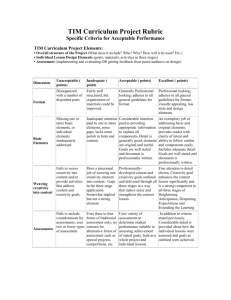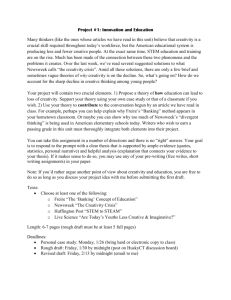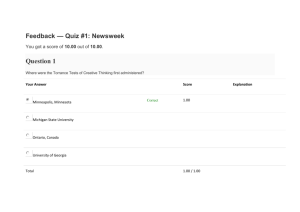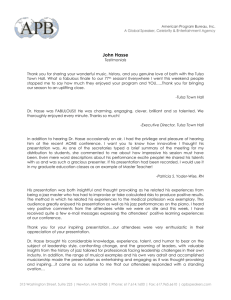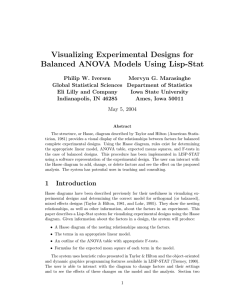0518_Scribe
advertisement
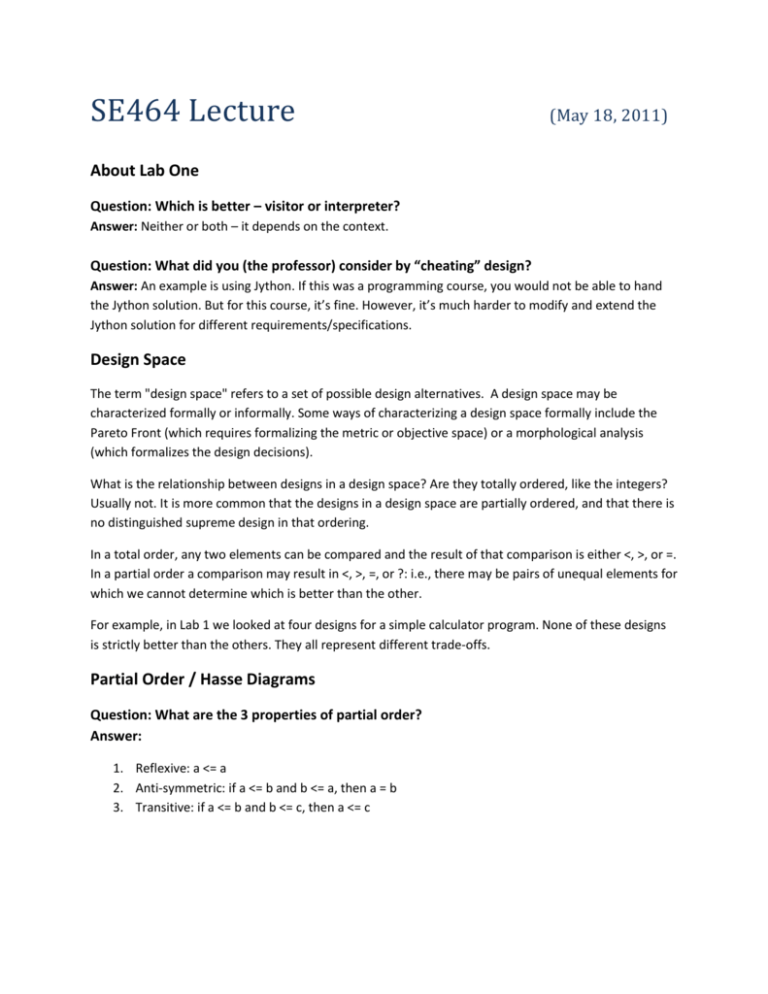
SE464 Lecture
(May 18, 2011)
About Lab One
Question: Which is better – visitor or interpreter?
Answer: Neither or both – it depends on the context.
Question: What did you (the professor) consider by “cheating” design?
Answer: An example is using Jython. If this was a programming course, you would not be able to hand
the Jython solution. But for this course, it’s fine. However, it’s much harder to modify and extend the
Jython solution for different requirements/specifications.
Design Space
The term "design space" refers to a set of possible design alternatives. A design space may be
characterized formally or informally. Some ways of characterizing a design space formally include the
Pareto Front (which requires formalizing the metric or objective space) or a morphological analysis
(which formalizes the design decisions).
What is the relationship between designs in a design space? Are they totally ordered, like the integers?
Usually not. It is more common that the designs in a design space are partially ordered, and that there is
no distinguished supreme design in that ordering.
In a total order, any two elements can be compared and the result of that comparison is either <, >, or =.
In a partial order a comparison may result in <, >, =, or ?: i.e., there may be pairs of unequal elements for
which we cannot determine which is better than the other.
For example, in Lab 1 we looked at four designs for a simple calculator program. None of these designs
is strictly better than the others. They all represent different trade-offs.
Partial Order / Hasse Diagrams
Question: What are the 3 properties of partial order?
Answer:
1. Reflexive: a <= a
2. Anti-symmetric: if a <= b and b <= a, then a = b
3. Transitive: if a <= b and b <= c, then a <= c
The above Hasse diagram shows the set of all subsets of the set {x, y, z}, ordered by inclusion (i.e., the
subset relation). This is an example partial order (from the Wikipedia page on partial orders). For
example, we see that the set {x, y} includes (is "greater than") the set {x}. However, the sets {x, y} and
{x, z} do not include each other and are not equal: they are "incomparable".
The partial order depicted in this Hasse diagram has a distinguished greatest element, namely the set {x,
y, z}. It also has a distinguished least element, namely the empty set.
There are rarely distinguished top and bottom elements in design spaces. There is usually no single best
or worst design. Imagine this Hasse diagram with the top and bottom removed. That's what most design
spaces look like.
The Pareto Front
This graph is used to represent the trade-offs in designs for two criteria. The ideal design will lie on the
origin of the graph. For example, the ideal spaceship will consume no fuel and will weight 0kg.
Practically though, the best design will fall on the Pareto front.
Question: What are the axes on the graph that Bill Moggridge uses to contrast different
design disciplines?
Answer: Physical Design to Digital (Conceptual proposed by Danial Jackson) Design vs. Technical
& Objective to Human & Subjective. (from May 6th scribe notes)
Question: What are the core skills of a designer? (Provided by class)
Answer:
Creativity
Analytical skills
Wisdom
Experience
Communication
o What experience did Fred Brooks have?
Answer: In the 60’s/70’s, before there were version control systems, people would work
separately on components and would try to make them fit together. However, this was
not an ideal solution because it would cause overlap and merge conflicts. Fred Brooks
experienced this in the IBM 360 project.
Being able to identify relevant metrics
Question: How do you generate new ideas? (Provided by class)
Answer:
Drugs (e.g. change morning coffee)
Talk/ask people outside of your scope of design and regular life
Modify existing ideas
Tell people that it’s a question for another problem
Research/read articles about a subject
Lie until it becomes the truth
Get ideas from movies/novels
Complain (data gathering)
Brainstorming
Ask someone who is more knowledgeable (e.g. Derek Rayside talked to a reference librarian in
preparation for this lecture)
Sleep
Experiment
Physical exercise
Take a bath
Suit up Barney Stinson style (always wear a tie)
Light physical activity (e.g. knitting, cook)
Travel (far/near)
Hobbies
Use Yahoo! Answers
Doodle
Fun Question: Who was the Harvard professor who had his tenure revoked?
Answer: Timothy Leary – he advocated that his students take acid.
On Local and Distant Analogies
Local analogy: comparing similar things (e.g. Mac was like Alto and Windows was like Mac).
Distant analogy: analogies between biological processes and genetic algorithm
On Intense and Casual Mode Creativity
Intense mode creativity is when you actually work on the problem and try to figure it out. Causal mode
creativity is where you work on the problem indirectly. For causal mode creativity to work, you must
have applied intense mode creativity previously. Sanders and Thagard discovered the claim that Alan
Turing would run 50km.
Aside: Alan Kay has his own shower in the basement of Xerox PARC.
Question: who was the first programmer?
Answer: Ada Lovelace
Question: Can creativity be done in a group?
Answer: Yes. Examples:
Brainstorming: unstructured
Synetics: group facilitator knows the real problem and transforms it into another problem, gives
it to a group to solve, and then change the solution to the real solution
Six Hats: different hats (roles) that are assigned to each person in a group. Example: one person
can have the “irrational” hat.
Can’t have a person that says “it sucks” because it kills morale.
Question: Are there systematic approach to finding new ideas?
Answer: Yes, for example, morphological analysis.
Question: If we were to relax the constraints, what would we get? Restaurants example
Answers:
Buffet
Charge you for the time/space
Bring your own food
Weak Form and Strong Form
Both “weak form” and “strong form” refer to generating new ideas by changing the technology.
Weak Form: change minor components in the design (e.g. change the ORM one is using).
Strong Form: change programming paradigms (e.g. students at Brown worked on introducing
continuation in web technologies).
Question: anyone can name a relational row store?
Answers:
Big Table - not suited for transactional model.
Oracle, Sybase, MySQL, SQL Server
Question: any other type of databases?
Answers:
Non-relational databases (NoSQL)
At Google they use relational column stores for logging
Some benefits for using relational column stores [1]:
They are more efficient when an aggregate needs to be computed over many rows but
only for a small subset of all columns of data.
They are more efficient when new values of a column are supplied for all rows at once.
Sample Questions:
1. Who is Ted Codd?
Answer: the inventor of relational databases
2. What property does the following equation infer? If A = B, and B = C, then A = C.
Answer: Transitivity
3. What is a necessary requirement for casual mode creativity to be effective?
Answer: Must have previously employed intense mode creativity.
4. What does it mean if a design is dominated? (in the context of a Pareto front)
Answer: There exists at least one other design that is strictly better than it on every criteria
under consideration.
References:
[1] http://en.wikipedia.org/wiki/Column-oriented_DBMS
Bibliography:
All images and content was derived from the SE464 lecture slides.






